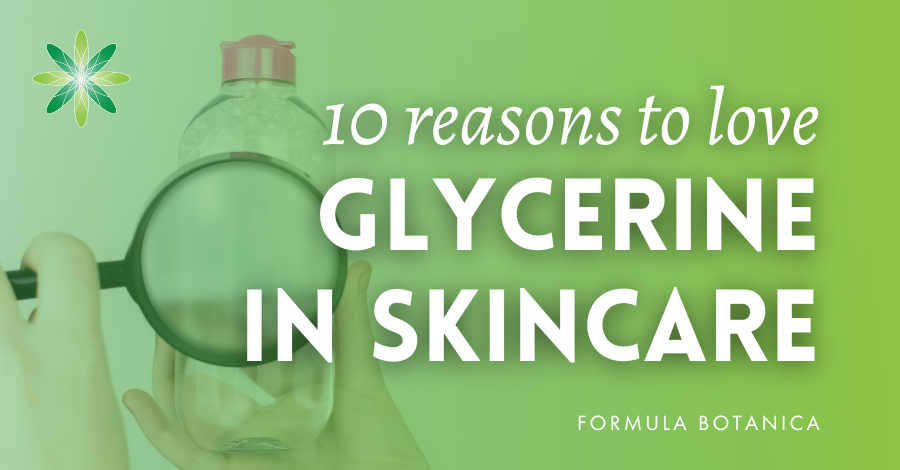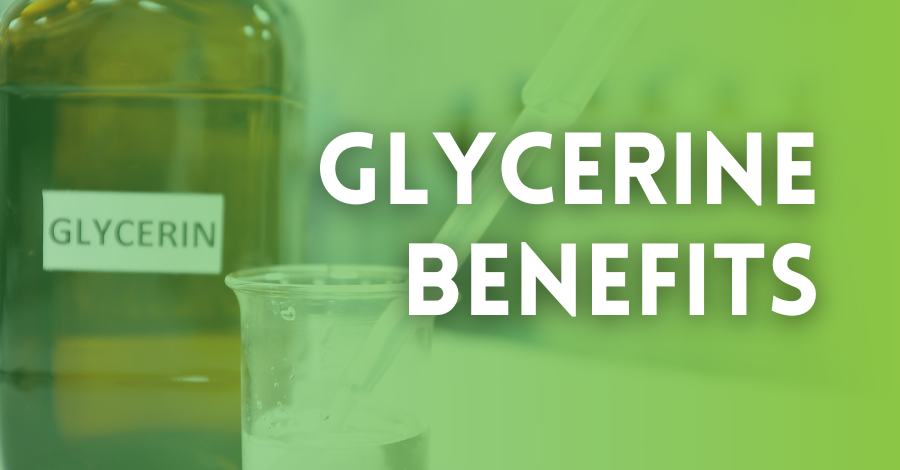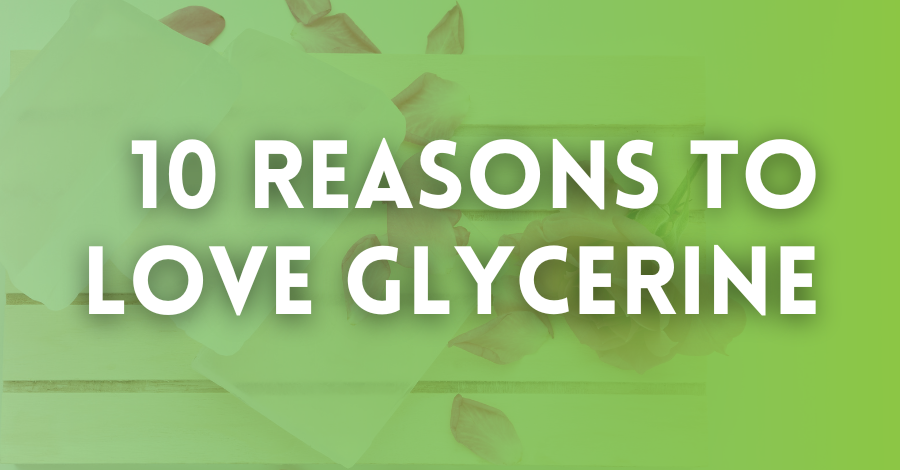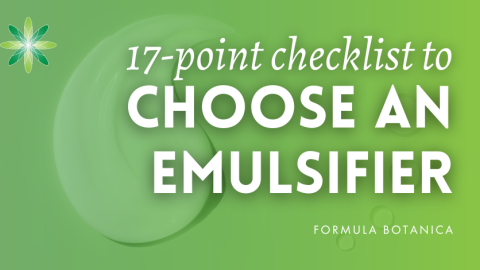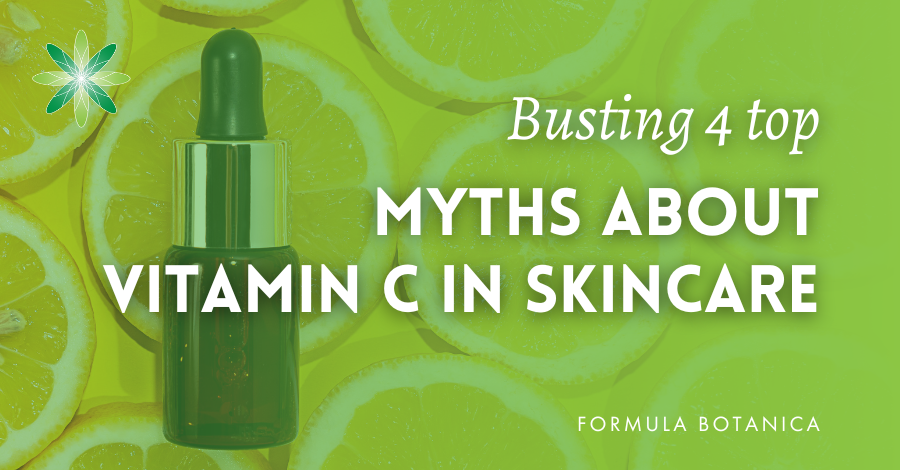If you are looking for versatile, effective, high-performance ingredients in your skincare and haircare formulations, then commonplace glycerine should definitely be on your radar. Glycerine has been reported as the third most frequently used cosmetic ingredient (i) and is a natural substance that has been used in cosmetic formulations for decades. Now, however, it is being feted as a hero ingredient rather than one hiding in the background in cosmetic formulations.
The rise in awareness of the need to maintain the skin barrier and a healthy skin microbiome, as well as growing demand for gentler cosmetics formulated for sensitive skin, has helped push humble, functional glycerine into the spotlight recently. Some cosmetic brands are promoting the skincare benefits of the high percentages of glycerine they are using within their formulations. They are suggesting that glycerine is far more tolerated by our skin than that other hydrating superstar, hyaluronic acid, and that it is particularly beneficial for sensitive or irritated skin (ii).
Glycerine is also on trend as a cheap, eco-friendly, natural ingredient that has been long overlooked. It is now making a comeback and clearly being seen as a high-performance ingredient in its own right, and for good reason.
In this blog post, we explore 10 reasons why glycerine benefits your skin and why it is a must-have ingredient in your cosmetic formulation toolkit.
First, we take a look at what it is, its chemical properties and its role.
What is glycerine?
Glycerine (INCI: Glycerin), also known as glycerol, is a colourless, odourless and viscous liquid that is derived from animal or vegetable fats and oils. It is a natural humectant, which means it attracts moisture and helps to retain it in the skin’s uppermost layers. By helping to keep the skin hydrated, it is a popular ingredient in moisturising products. But glycerine is more than just a moisturiser, as we will see later.
Chemically, glycerine is a trihydroxy alcohol, meaning it has three hydroxyl (-OH) groups in its structure. This makes it soluble in both water and alcohol. It can be used in water-based formulations and works particularly well in emulsion formulations that require both water and oil phases (note that it can’t be used in oil-based formulations that do not contain water or an emulsifier). You will also be familiar with glycerine in food products as a sweetener, preservative, and thickening agent.
Is glycerine good for your skin?
Glycerine is a multifunctional ingredient that provides numerous benefits for the skin. Its ability to act as a humectant, solvent and dispersant, along with its emollient-type properties, make it a valuable ingredient in many cosmetic formulations. Its compatibility with other ingredients makes it an excellent ingredient for skincare products. Let’s take a look at these roles in detail.
Glycerine as a humectant
One of the primary functions of glycerine in cosmetics is its ability to act as a humectant. Humectants help the skin to retain moisture by attracting water molecules from the environment and, depending on the aridity of the air, they may also draw water from deeper layers of the skin. In either case, glycerine in topical skincare visibly helps plump the stratum corneum (the outermost layer of the epidermis). You can find out more about how humectants work in our post:
Formulator’s guide to humectants
See also our article: Essential 101 guide to the skin barrier.
Glycerine as a moisturiser
Glycerine helps maintain crystallinity/fluidity of cell membranes and intracellular lipids, thereby reinforcing the skin barrier to help prevent transepidermal water loss (TEWL). This also has the effect of making the skin feel smoother. Glycerine-containing formulations are therefore of particular benefit for people with dry and dehydrated skin types.
Glycerine as an emollient
Glycerine, while not classed as an emollient, does have an emollient-like property as it soothes and softens the skin. It works well when combined with occlusives and emollients, such as in emulsion formulations, where it helps reinforce their properties to keep the skin supple, soft, and hydrated.
Glycerine as a dispersant
Glycerine is used as a wetting agent to help disperse gums in order to reduce their surface tension and allow for their better dispersion when added to the aqueous phase of the formulation. It helps attract water to hydrate the gums. In making emulsions, powdered gums are generally dispersed in a small percentage of glycerine in order to blend them into the emulsion without clumping.
Glycerine as a solvent
The Formula Botanica student community loves making and using jewel-coloured glycerites in their formulation. Glycerites are made by macerating dried botanical matter into glycerine. They are a convenient and attractive way to include the beneficial phytoactive properties of plants in a formulation and to use glycerine in a more creative way. Discover all about glycerites and how to make your own in our post:
Tips on formulating skincare with glycerine
When it comes to formulating with glycerine, there are a few important tips and tricks to keep in mind to ensure you’re using it effectively and efficiently in your cosmetic products. Glycerine is often used at high levels in rinse-off cosmetics; however, as we mentioned, some cosmetic brands are including very high percentages of glycerine in leave-on products, such as serums. They have reasons for doing this and will have looked carefully at their formulations to ensure ingredient compatibility and that the product functions as intended as well as offering the user an optimal experience.
Do’s and don’ts when using glycerine in formulations
Glycerine acts as a humectant by attracting moisture from the air and also by drawing water from the deeper layers of the skin to visibly plump and hydrate its uppermost layers. However, these benefits may be lost through TEWL if the formulation does not contain emollient and/or occlusive ingredients that can help form a film on the stratum corneum. It is important to use glycerine at an appropriate level for your formulation and product type, as it can create a tacky skin feel at high percentages.
Combinations of glycerine with other skincare ingredients
To get the best results from glycerine in your formulations, it’s important to consider the other ingredients you’re using and how they might interact with glycerine. One important thing to note is that glycerine should be added to the water phase of the formulation to ensure proper dispersion. Glycerine can work well with other humectants, such as hyaluronic acid, as well as with emollients like shea butter or jojoba oil. It works well at and is stable within the pH ranges used in cosmetics.
How to calculate the amount of glycerine in formulations
Let’s look at some figures for glycerine’s use in cosmetics. A survey conducted by the Personal Care Products Council (2014) of the maximum use concentrations of glycerine in cosmetics showed its use at concentrations up to 79.2% in leave-on products, 99.4% in rinse-off products, 47.9% in products diluted for the bath, 40.6% in eye lotions, and 99.4% in skin cleaning products. (iii) There is huge variation in the percentage used, but there are rules of thumb for leave-on and rinse-off products.
A good starting point is to use glycerine at around 3-5% of your leave-on, emulsion-based formulations, but you may need to adjust this according to the other ingredients you’re using and the desired function and skin feel of the product. For instance, if you are using another humectant as well, you need to think through how this will affect the desired performance of the cosmetic.
Glycerine can, in theory, be used up to 100% levels, but high concentrations of glycerine can cause a sticky or tacky texture in the final product. If you wish to make glycerine more of a hero ingredient in your leave-on formulations, edge up to 10% glycerine and see how it performs. Some brands are using glycerine and glycerites at 6-30% levels to promote the super-hydrating and skin barrier roles (iv) they can provide in larger amounts.
When the function of glycerine is to disperse gums, it is present at about 1-3%.
10 reasons to love using glycerine in skincare
To conclude, let’s recap the benefits of glycerine so you can see at a glance why it is worth exploring this ingredient in your formulations for its star qualities.
1. Moisturising
Glycerine helps to improve the skin’s texture and appearance by reinforcing the skin barrier.
2. Humectant
As a humectant, glycerine helps plump and hydrate the skin by attracting moisture from the air and from the deeper layers of the skin. This makes it a popular ingredient in moisturising products and serums.
3. Emollient
Glycerine has emollient-like properties that help soften and soothe the skin.
4. Non-irritating
Glycerine is a non-irritating ingredient that is suitable for all skin types, including sensitive skin. It has a gentle, moisturising effect that can help soothe and calm irritated or inflamed skin. Glycerine is considered safe; however, some people with sensitive skin may experience mild irritation or allergic reactions to glycerine.
5. Antimicrobial
Glycerine has weak antimicrobial properties (v). It helps reduce the water activity of formulations, thus reducing the water available for microorganisms to thrive (it works as a type of bacteriostatic and fungistatic agent). This makes it a popular ingredient in products such as hand cleansers and soaps.
6. All skin types
Glycerine is suited for products aimed at all skin types, although percentages need to be varied in formulations to ensure it is efficacious for the product type. It is well tolerated by both sensitive and dry skin as well as oily or acne-prone skin.
7. Versatile
Glycerine is a versatile ingredient that can be used in a wide range of cosmetic formulations, from leave-on to rinse-off products, including creams, lotions, serums, soaps, sanitisers, and shampoos. It combines well with other ingredients in aqueous formulations.
8. Anti-ageing
Glycerine can help reduce the visible signs of ageing by acting as a humectant to hydrate the skin. It has a stabilising effect on collagen (vi), which helps to improve the skin’s elasticity and firmness.
9. Soothing
It has a cooling effect on the skin, making it a great ingredient for formulations designed to soothe and calm irritated or inflamed skin. It also helps to improve the skin’s barrier function, protecting it from external factors like pollution, UV radiation, and harsh weather conditions.
10. Eco-friendly
Glycerine is a natural ingredient that is biodegradable. It can be derived from renewable and responsibly grown and harvested palm, soy and coconut oils, making it a potentially sustainable choice for cosmetic formulations.
We could add a final advantage: glycerine is a cost-effective ingredient, which makes it a definite winner to incorporate into your formulations.
Glycerine in skincare – conclusions
Overall, incorporating glycerine into your cosmetic formulations is a smart choice that can lead to better, more effective products. As you explore the world of natural cosmetic formulations, remember the many benefits that glycerine has to offer, not just for its functional roles but as a hero ingredient.
Further reading and references
(i), (iii) Lilian C. Becker et al., 2019: Safety assessment of glycerine as used in cosmetic products.
(ii) Glossy Pop, 25th November, 2022: Beauty brands are trying to reinvent glycerin.
(iv) M Lodén 1, and W Wessman, 2001: The influence of a cream containing 20% glycerin and its vehicle on skin barrier properties.
(v) Stout EI, McKessor A.; 2012: Glycerin-based hydrogel for infection control.
(vi) R. Penkova et al., 1999: Stabilizing effect of glycerol on collagen type I isolated from different species.
Leave us a comment

Liz was Formula Botanica’s Content Coordinator between August 2020-2024. Liz worked as a professional blogger, journalist and site developer for many years and was also part of the Formula Botanica student community. Read more about the Formula Botanica Team.

